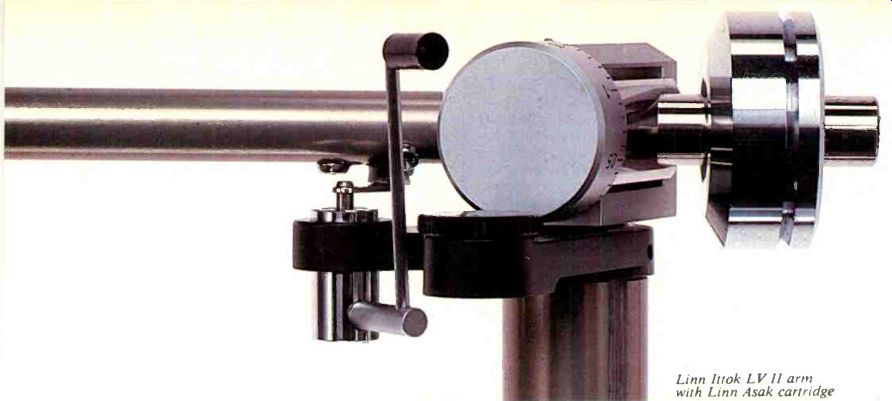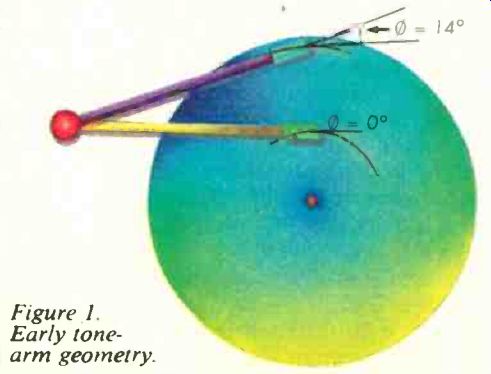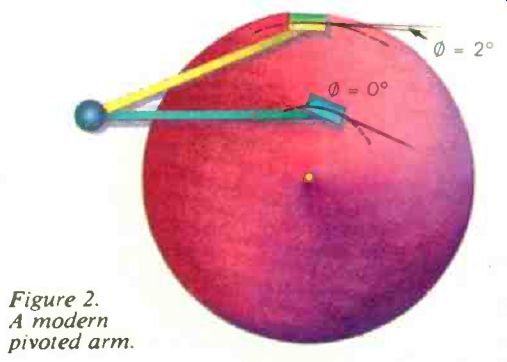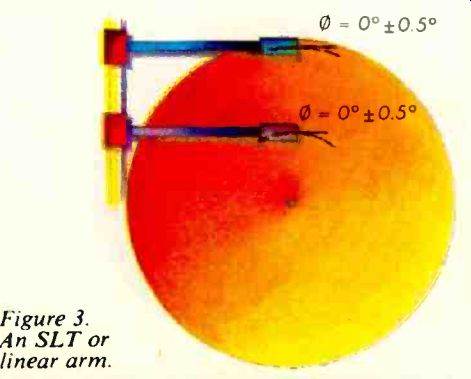by E. Brad Meyer
In principle, the tone arm's job is a simple one, but real records present real problems to both pivoted and linear-tracking arms.
Over the past four years we have seen an increase in the number of integrated turn tables equipped with straight-line-tracking (SLT) tone arms. Sometimes called a "linear" or "radial" arm, the SLT moves in a straight line across the record. The front end follows the stylus in the groove, while the back end rides either on a low-friction bearing or, more commonly, on a carriage driven by a servo-controlled motor.
SLT arms used to be complex, delicate, and very expensive, and current add-on versions are still high-end items, ranging in price from $600 to $2,800. But improvements in design and manufacturing technology have made possible integrated turntables equipped with linear arms for much less-under $300, some for as little as $110.


Linn Ittok LV II arm with Linn Asak cartridge
Even with more efficient manufacturing, though, an SLT arm still costs more than a pivoted arm of comparable materials and construction. Why should you pay extra for one? The answer is that often the linear arm simply sounds better, with tighter bass, a more stable stereo image, improved tracking, and greater immunity to warps and vibration. And, because the arm is controlled by a servo, it's easier to add convenience features such as programmable selection of individual cuts.
There are two common explanations for the sonic merits of SLT arms, both relating to the way in which they position the cartridge on the record.
Except under certain unusual conditions, however, both these explanations are wrong. The SLT's real virtue lies in the dynamic properties of the design.
Other things being equal, an SLT arm is shorter, stiffer, and lighter than its pivoted counterpart.
To understand the difference between SLT and pivoted arms, we must examine them from two viewpoints. The first of these is geometrical. The dimensions and shape of a tone arm determine the position of the cartridge as it moves across a record, at least under theoretically ideal conditions:
the record is perfectly flat, A the grooves are concentric with the center hole, and the entire record-playing system is free of externally induced vibration.
In the real world, though, records are warped, their grooves are eccentric, and vibration is always a problem. So we must also look at the complex mechanical system formed by the arm and cartridge together to determine how closely the system approximates its theoretical performance.

Figure 1.
Early tonearm geometry
--------
Figure 1 shows a hypothetical arm constructed of modern materials but with the geometry of a typical acoustical phonograph built before World War II.
The stylus and the transducer that takes the place of a modern cartridge are aligned with the axis of the arm. We would like the transducer to be tangential to the groove at the stylus; if it isn't, the waveform picked up from the groove will be distorted. As you can see from the drawing, the arm's axis parallels the tangent to the groove at just one point, shown here near the inside of the recorded area. At the out side edge, there is a large horizontal tracking error equal to the angle (0) between the axis of the arm and the tangent to the groove.
Figure 2 shows a modern pivoted arm. Note that the stylus contacts the groove to the right of the point at which the arm's axis is tangential to it. The cartridge is mounted at an angle, called the offset angle, that makes up for the arm's extension beyond this point of tangency. The reason for doing things this way is that when the arm is bent just the right amount and mounted at just the right distance from the center spindle, the stylus describes an arc that keeps the cartridge very nearly tangent to the groove at all points. This deceptively clever design, together with the equations for calculating the optimum arm length, offset angle, and mounting point, were first published about forty years ago-though some of to day's arm designers still seem unaware of them.
Notice that we just said the stylus stays "very nearly" tangent to the groove. Even with the optimum setup, there is some residual error in the horizontal tracking angle. In a properly designed arm this error is greatest near the beginning of the record (where the alignment is least critical), at which point it amounts to about 2 degrees. It changes constantly as the arm moves inward, actually reaching zero at two different groove radii and finally increasing to about 0.8 degree near the center. The horizontal tracking error can be seen in the figure.
Now look at Figure 3, which shows an SLT arm.
The crucial question in any SLT design is how to get the back of the arm to follow the stylus across the record. One very expensive model has a tiny arm tube mounted on a low-friction, zero-tolerance ball bearing; in others the arm doesn't touch its guide at all but rests on a thin cushion of air supplied by a remotely mounted pump. In all the new integrated SLT turntables the carriage is driven along a track by a small motor.
If all records were cut with a single standard groove spacing, or "pitch," an SLT arm's drive motor could run at a constant speed and maintain perfect tangency all the way across the disc. But real records are cut with variable pitch, so that the adjacent groove walls are close together in soft passages and spread out to allow for greater excursion when the music gets loud. To make sure the back of the arm doesn't lag behind the front, the drive motor must be able to move it fast enough to follow the loudest passage on any record. But that's fast enough to overrun the stylus during soft passages, so the motor must be able to switch itself on and off as needed.
The result is that while the front end follows the groove, the back end moves forward in short spurts. First it lags slightly behind the front, then it overspeeds briefly, then it stops and waits for the cartridge to catch up.
Typically, the difference between where the arm motor cuts in and where it shuts off amounts to about 1 degree of horizontal angle, meaning that instead of maintaining zero tracking error, the arm will cycle between +0.5 degree and-0.5 degree. This is distinctly less than the pivoted arm's error near the outside of the disc, but it is not really very different in the crucial inner portion.
In fact, horizontal tracking error is not a source of significant audible distortion in either type of arm as long as both the designer and the cartridge installer have done their jobs correctly. For some mysterious reason, many mass-produced pivoted arms still do not conform to the basic design equations that have been around for decades. And even in a correctly designed arm, a carelessly installed cartridge can double or triple the tracking error. The mounting of the cartridge is just as critical in the SLT arm. (Some recent cartridges come with special hardware to ensure correct mounting. If yours didn't, you should buy or borrow a separate alignment gauge and follow its instructions rather than those of the turntable manufacturer.)

Figure
2. A modern pivoted arm.
One respect in which most tone arms, SLT or pivoted, are in error-and for which the equations have also been known for decades-is the location of the arm's vertical pivot. For the least wow, the vertical pivot point should be as close as possible to the plane of the record. Ideally, the record and the pivot point should be at the same height from the turntable base. While this is relatively simple to achieve with a horizontally pivoted arm or a long SLT arm, almost all turntables, surprisingly, have their arms' vertical pivots in the wrong place (too high, usually). Designs employing short SLT arms, less than a record radius in length, cannot have their vertical pivot points in the plane of the record without some complex mechanical trickery that has never been implemented in any arm I know of.
A second supposed advantage of the SLT arm is that it generates no skating force. In the pivoted arm, the offset position of the stylus means that the force of the friction be tween stylus and groove isn't aligned with the arm's pivot point. It therefore produces a torque around the pivot-the skating force-that tends to pull the arm inward. Unless the skating force is counterbalanced, the stylus will consequently be deflected slightly outward, increasing distortion. No simple mechanism can perfectly balance this skating force, which varies according to the level and frequency content of the music and decreases steadily as the arm moves inward.
The SLT arm, tracking along one disc radius, generates no skating force. And many SLT's seem to be able to track certain violently cut records better than most pivoted arms. But, here again, intuition must yield to careful measurement and calculation. The skating force on a pivoted arm varies between about 7 and 15 percent of the vertical tracking force.
Adjusting the antiskating compensation for equal distortion in the loudest passages of a special test record--which is the best way to do it--will balance the arm so as to produce even stylus pressure and optimum cantilever deflection during the most difficult passages. The few remaining milligrams of imbalance during softer portions won't produce significant distortion.
The clincher in the skating-force argument is that the best arms of either type will track the toughest records about equally well, while inferior designs, linear or pivoted, have trouble. There is something else afoot, and to find out what we must turn our attention from static properties to dynamic ones.
The tone arm's job is in principle a simple one: to hold the cartridge in position over the groove with just the right downward force on the stylus and to move it across the record inward spiral. Since the stylus assembly--meaning the stylus itself and the little shaft, called the cantilever, that holds it--is small and delicate, it makes sense that the bearings that support the arm should have very low friction. At first glance, it might seem that once this requirement is met, the arm designer's job is done.
But a closer look reveals-surprise!-various complications. Since it is the relative motion of the stylus with respect to the cartridge body that produces the electrical signal, we want the cartridge to hold still while the stylus moves. Since the arm has very low friction, it must be inertia that keeps it from following the motion of the stylus and canceling out the signal. So the arm and cartridge need to have a certain minimum weight-or, more accurately, sufficient effective mass-to do their job properly.
But real records and turntables suffer from warps, eccentricity, and external vibration. The groove over which the cartridge is supposed to remain "stationary" is doing a dance of its own. Now it appears that the mass we were counting on to keep things under control has become a liability, be cause we want the cartridge to follow the center-line of the groove like a skillful partner in the dance. We've got conflicting requirements.
To find a way out of this predicament, we must first notice that the arm and cartridge form a mass that sits on a spring formed by the cantilever suspension. A mass sitting on a spring will, if perturbed, tend to vibrate at a certain resonant frequency. That frequency is deter mined by the mass and the amount of give, or compliance (the opposite of stiffness), in the spring. The higher the mass or the higher the compliance, the lower the resonant frequency; the lower the mass or compliance (that is, the stiffer the spring), the higher the frequency.
This is the key to the system's behavior below the resonant frequency, the cartridge, arm, and stylus move together as a unit, producing no output; well above the resonance, the cartridge holds still while the stylus moves, producing an accurate replica of the musical waveform; at the resonance, the arm actually moves farther than the stylus, producing a peak in the response.

Figure
3. An SLT or linear arm.
Now, given that the arm and cartridge are going to resonate at some frequency, where do we want it to be? The resonance should fall below 20 Hz, to keep the frequency-response peak from affecting the mu sic, and above the region from 2 to 5 Hz, where record warps can cause serious flutter. Of the two possible kinds of error, too low a resonant frequency causes more obvious problems. A rise of a few deci bels at 20 Hz will matter little with most speakers, but flutter and groove-skipping are always audible.
Cartridges themselves often contribute almost enough mass for correct system performance, and modern moving-magnet models tend to have very high compliance for improved tracking. (Modern low-compliance-coil cartridges are a special case, requiring a slightly heavier arm for best results.) In practice the arm designer generally wants to minimize the mass of the arm as far as possible consistent with adequate stiffness; a metal arm tube that flexes too easily may be plagued by internal resonances well into the midrange.
Now--finally--the straight-line-tracking arm's true advantages emerge. Most regular arms are about 9 inches long from stylus to pivot, but the SLT arm can be 6 inches, the radius of the record or even shorter if the arm assembly can be lowered over the turntable after the record is in place. (This is one advantage of the "clamshell" type of turntable that has the entire arm mechanism mounted on the inside of the dust cover.) A shorter arm can offer a better combination of low mass and high rigidity.
The tracking of warps is good, the arm is free of internal resonances, and it is relatively immune to external vibration, allowing higher playback levels without acoustic feedback. As we noted earlier, however, short SLT arms will have vertical pivots that are higher than optimal. You can't have everything.
When all is said and done, you may well find that an SLT arm works best in your system-not because it tracks the record the way it was cut or because it has no offset, but because it is both light and rigid without being expensive.
====================
Also see: Record Wear (Jan. 1985)
Source: Stereo Review (USA magazine)